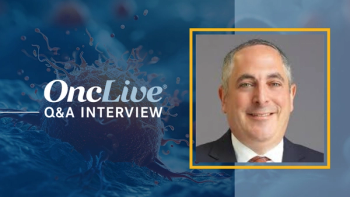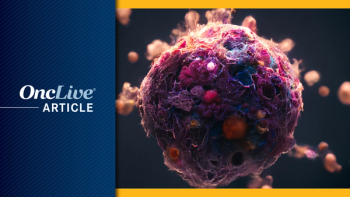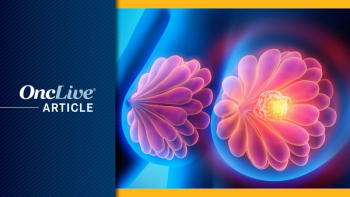
Venetoclax Shows Single-Agent Activity in AML
Treatment with single-agent BCL-2 inhibitor venetoclax demonstrated an overall response rate of 19% with a tolerable safety profile in patients who were unfit for intensive chemotherapy for those with relapsed/refractory acute myeloid leukemia.
Anthony Letai, MD, PhD
Treatment with single-agent venetoclax (Venclexta) demonstrated an overall response rate (ORR) of 19% with a tolerable safety profile for patients with relapsed/refractory acute myeloid leukemia (AML) or those with AML who were unfit for intensive chemotherapy, according to phase II results published in Cancer Discovery.1
In the single-arm phase II study, the ORR achieved with the BCL-2 inhibitor consisted of 2 (6%) complete responses (CR) and 4 (13%) CRs with incomplete blood count recovery (CRi). The median duration of CR was 48 days. Additionally, 19% of patients treated with at least 1 dose of venetoclax at 800 mg showed signs of antileukemic activity that did not meet the criteria for response.
"In this clinical trial, we found that even among pretreated patients whose AML was refractory to intensive chemotherapy, there was evidence of exceptional sensitivity to selective BCL-2 inhibition, even to the point of complete remissions," senior author Anthony Letai, MD, PhD, Dana-Farber Cancer Institute, said in a statement. "This could be accomplished by a single oral dose of venetoclax daily and demonstrated the potential clinical activity of BCL-2 inhibition in AML."
In the study, 32 patients received at least 1 dose of venetoclax. The median age of patients was 71 years and most were Caucasian (78%). The ECOG performance status was primarily 1 (44%) or 2 (44%). IDH mutations were documented in 38% of participants, and 13% had FLT3-ITD alterations.
A majority of patients had a prior hematologic disorder or myeloproliferative neoplasm (41%), and 4 patients had therapy-related AML (13%). Two patients were treatment-naive, and were deemed unfit for intensive chemotherapy. The majority of patients had received at least 1 prior therapy (94%), and 41% had received at least 3 prior therapies. The most common prior therapies were hypomethylating agents (72%) and standard 7+3 induction therapy (53%).
Of those who received a prior hypomethylating agent (n = 24), the ORR was 25%, which consisted entirely of CR/CRi. In those with IDH mutations (n = 12), the CR/CRi rate was 33%, which was split evenly between CRs (17%) and CRis (17%).
The 6-month overall survival (OS) rate was 36% (95% CI, 20-53) and the median OS was 4.7 months. The leukemia-free survival (LFS) rate at 6 months was 10% and the median LFS was 2.3 months.
A biomarker was developed utilizing expression of BCL-2, BCL-XL, and the ratio between these two markers. Patients marked as sensitive for BCL-2 inhibition using this marker experienced a longer duration on venetoclax therapy (P = .0381). Further biomarker testing also revealed a potential role for BH3 profiling for identifying those who were most likely to respond to treatment with venetoclax, although these findings will require further validation.
"This is significant as it supports the mechanism of action of venetoclax as an on-target inhibitor of BCL-2. Moreover, it offers the possibility of using BH3 profiling as a potential predictive biomarker for clinical use of BH3 mimetics," Letai said.
After a median time on study of 63.5 days, all patients had discontinued treatment. The most common cause for stopping therapy was progressive disease, with 1 patient stopping due to terminal ileitis. One patient proceeded to allogeneic hematopoietic stem cell transplant after achieving stable disease.
"We believe that venetoclax will soon become an equal partner to standard-of-care chemotherapy in elderly patients with AML when used in combinations with hypomethylating agents and other approaches," lead investigator of the study Marina Konopleva, MD, PhD, from The University of Texas MD Anderson Cancer Center, said in a statement. "Planned studies will test the hypothesis that venetoclax may likewise improve outcomes in younger AML patients when combined with high-dose chemotherapy."
In January 2016, venetoclax received an FDA breakthrough therapy designation for use in combination with hypomethylating agents in treatment-naïve patients with AML who are not eligible for standard high-dose induction treatment. This designation, which will expedite the development and review for the medication, was based on data from a small early-stage trial in which over 70% of untreated patients with AML had clinical responses to combination venetoclax therapy.2
In April 2016, the FDA granted an accelerated approval to venetoclax as a treatment for patients with chronic lymphocytic leukemia (CLL) who have a 17p deletion following at least 1 prior therapy. This decision was primarily based on data from the phase II M13-982 study, in which venetoclax elicited responses in nearly 80% of patients with relapsed/refractory del17p CLL.3
"It is also worth noting that in this age of precision medicine, dominated by genomics, this is an example of the importance of functional precision medicine," said Letai. "CLL and AML lack genetic abnormalities related to BCL-2. Instead, their vulnerability to BCL-2 inhibition was identified using functional studies. This is support that functional studies need to be part of any mature precision medicine project."
Numerous studies continue to assess venetoclax as a single-agent and as part of combination strategies. The agent is being explored with anti-CD20 agents and the BTK inhibitor Ibrutinib for patients with CLL and as part of a combination treatment for those with AML.
References
- Konopleva M, Pollyea DA, Potluri J, et al. Efficacy and Biological Correlates of Response in a Phase II Study of Venetoclax Monotherapy in Patients with Acute Myelogenous Leukemia [published online August 12, 2016]. Cancer Discovery. 2016. doi: 10.1158/2159-8290.CD-16-0313
- DiNardo C, Pollyea D, Pratz K, et al. A phase 1b study of venetoclax (ABT-199/GDC-0199) in combination with decitabine or azacitidine in treatment-naive patients with acute myelogenous leukemia who are ≥ to 65 years and not eligible for standard induction therapy. Presented at: 2015 ASH Annual Meeting; December 5-8, 2015; Orlando, Florida. Abstract 327.
- Stilgenbauer S, Eichhorst BF, Schetelig JS, et al. Venetoclax (ABT-199/GDC-0199) monotherapy induces deep remissions, including complete remission and undetectable MRD, in ultra-high risk relapsed/refractory chronic lymphocytic leukemia with 17p deletion: results of the pivotal international phase II study. Presented at: 57th American Society of Hematology Annual Meeting; Orlando, Florida; December 5-8, 2015. Abstract LBA6.
All patients treated in the trial experienced at least 1 adverse event (AE). The most common grade 3/4 AEs were febrile neutropenia (31%), hypokalemia (22%), pneumonia (19%), hypotension (13%), and urinary tract infection (13%). Serious AEs were experienced by 84% of patients and most commonly included febrile neutropenia (28%) and pneumonia (16%).

























































































